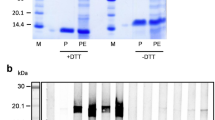Abstract
Animal models of disease enable the study of the pathology, biomarkers, and treatments for the disease being studied. These models become particularly useful in the study of diseases, such as peanut allergy, that currently have no FDA-approved therapy options. Here, we describe a mouse model of peanut allergy using a peanut extract and cholera toxin that can be applied to both BALB/c and C3H/HeJ mouse strains. Sensitization is induced through the gastrointestinal tract resulting in elevated levels of peanut-specific IgE and anaphylaxis upon challenge with peanut proteins. This model has been used to study the cells and molecules involved in the development of peanut allergy and to evaluate novel immunotherapy approaches and the underlying mechanisms of immunotherapy. Potential utilities of this model are numerous and may include studies on microbial influences on peanut allergy and discovery of biomarkers of anaphylaxis.
Access this chapter
Tax calculation will be finalised at checkout
Purchases are for personal use only
Similar content being viewed by others
References
Boyce JA, Assa'ad A, Burks AW, Jones SM, Sampson HA, Wood RA, Plaut M, Cooper SF, Fenton MJ, Arshad SH, Bahna SL, Beck LA, Byrd-Bredbenner C, Camargo CA Jr, Eichenfield L, Furuta GT, Hanifin JM, Jones C, Kraft M, Levy BD, Lieberman P, Luccioli S, McCall KM, Schneider LC, Simon RA, Simons FE, Teach SJ, Yawn BP, Schwaninger JM (2011) Guidelines for the diagnosis and management of food allergy in the United States: summary of the NIAID-sponsored expert panel report. Nutr Res 31(1):61–75. https://doi.org/10.1016/j.nutres.2011.01.001
Tang ML, Mullins RJ (2017) Food allergy: is prevalence increasing? Intern Med J 47(3):256–261. https://doi.org/10.1111/imj.13362
Sicherer SH, Munoz-Furlong A, Godbold JH, Sampson HA (2010) US prevalence of self-reported peanut, tree nut, and sesame allergy: 11-year follow-up. J Allergy Clin Immunol 125(6):1322–1326. https://doi.org/10.1016/j.jaci.2010.03.029
Ang WX, Church AM, Kulis M, Choi HW, Burks AW, Abraham SN (2016) Mast cell desensitization inhibits calcium flux and aberrantly remodels actin. J Clin Invest 126(11):4103–4118. https://doi.org/10.1172/JCI87492
Burks AW (2008) Peanut allergy. Lancet 371(9623):1538–1546. https://doi.org/10.1016/S0140-6736(08)60659-5
King RM, Knibb RC, Hourihane JO (2009) Impact of peanut allergy on quality of life, stress and anxiety in the family. Allergy 64(3):461–468. https://doi.org/10.1111/j.1398-9995.2008.01843.x
Avery NJ, King RM, Knight S, Hourihane JO (2003) Assessment of quality of life in children with peanut allergy. Pediatr Allergy Immunol 14(5):378–382
Bock SA, Munoz-Furlong A, Sampson HA (2001) Fatalities due to anaphylactic reactions to foods. J Allergy Clin Immunol 107(1):191–193. https://doi.org/10.1067/mai.2001.112031
Bock SA, Munoz-Furlong A, Sampson HA (2007) Further fatalities caused by anaphylactic reactions to food, 2001–2006. J Allergy Clin Immunol 119(4):1016–1018. https://doi.org/10.1016/j.jaci.2006.12.622
Iweala OI, Burks AW (2016) Food allergy: our evolving understanding of its pathogenesis, prevention, and treatment. Curr Allergy Asthma Rep 16(5):37. https://doi.org/10.1007/s11882-016-0616-7
Virkud YV, Burks AW, Steele PH, Edwards LJ, Berglund JP, Jones SM, Scurlock AM, Perry TT, Pesek RD, Vickery BP (2017) Novel baseline predictors of adverse events during oral immunotherapy in children with peanut allergy. J Allergy Clin Immunol 139(3):882–888.e5. https://doi.org/10.1016/j.jaci.2016.07.030
Burton OT, Logsdon SL, Zhou JS, Medina-Tamayo J, Abdel-Gadir A, Noval Rivas M, Koleoglou KJ, Chatila TA, Schneider LC, Rachid R, Umetsu DT, Oettgen HC (2014) Oral immunotherapy induces IgG antibodies that act through FcgammaRIIb to suppress IgE-mediated hypersensitivity. J Allergy Clin Immunol 134(6):1310–1317.e1316. https://doi.org/10.1016/j.jaci.2014.05.042
Nowak-Wegrzyn A, Sampson HA (2011) Future therapies for food allergies. J Allergy Clin Immunol 127(3):558–573.; quiz 574–555. https://doi.org/10.1016/j.jaci.2010.12.1098
Plundrich NJ, Kulis M, White BL, Grace MH, Guo R, Burks AW, Davis JP, Lila MA (2014) Novel strategy to create hypoallergenic peanut protein-polyphenol edible matrices for oral immunotherapy. J Agric Food Chem 62(29):7010–7021. https://doi.org/10.1021/jf405773b
Kulis M, Wesley Burks A (2015) Effects of a pre-existing food allergy on the oral introduction of food proteins: findings from a murine model. Allergy 70(1):120–123. https://doi.org/10.1111/all.12519
Kulis M, Gorentla B, Burks AW, Zhong XP (2013) Type B CpG oligodeoxynucleotides induce Th1 responses to peanut antigens: modulation of sensitization and utility in a truncated immunotherapy regimen in mice. Mol Nutr Food Res 57(5):906–915. https://doi.org/10.1002/mnfr.201200410
Kulis M, Macqueen I, Li Y, Guo R, Zhong XP, Burks AW (2012) Pepsinized cashew proteins are hypoallergenic and immunogenic and provide effective immunotherapy in mice with cashew allergy. J Allergy Clin Immunol 130(3):716–723. https://doi.org/10.1016/j.jaci.2012.05.044
Kulis M, Chen X, Lew J, Wang Q, Patel OP, Zhuang Y, Murray KS, Duncan MW, Porterfield HS, WB A, Dreskin SC (2012) The 2S albumin allergens of Arachis hypogaea, Ara h 2 and Ara h 6, are the major elicitors of anaphylaxis and can effectively desensitize peanut-allergic mice. Clin Exp Allergy 42(2):326–336. https://doi.org/10.1111/j.1365-2222.2011.03934.x
Kulis M, Wan CK, Gorentla BK, Burks AW, Zhong XP (2011) Diacylglycerol kinase zeta deficiency in a non-CD4(+) T-cell compartment leads to increased peanut hypersensitivity. J Allergy Clin Immunol 128(1):212–214. https://doi.org/10.1016/j.jaci.2011.02.035
Kulis M, Li Y, Lane H, Pons L, Burks W (2011) Single-tree nut immunotherapy attenuates allergic reactions in mice with hypersensitivity to multiple tree nuts. J Allergy Clin Immunol 127(1):81–88. https://doi.org/10.1016/j.jaci.2010.09.014
Orgel KA, Duan S, Wright BL, Maleki SJ, Wolf JC, Vickery BP, Burks AW, Paulson JC, Kulis MD, Macauley MS (2017) Exploiting CD22 on antigen-specific B cells to prevent allergy to the major peanut allergen Ara h 2. J Allergy Clin Immunol 139(1):366–369.e362. https://doi.org/10.1016/j.jaci.2016.06.053
Pons L, Ponnappan U, Hall RA, Simpson P, Cockrell G, West CM, Sampson HA, Helm RM, Burks AW (2004) Soy immunotherapy for peanut-allergic mice: modulation of the peanut-allergic response. J Allergy Clin Immunol 114(4):915–921. https://doi.org/10.1016/j.jaci.2004.06.049
Author information
Authors and Affiliations
Corresponding author
Editor information
Editors and Affiliations
Rights and permissions
Copyright information
© 2018 Springer Science+Business Media, LLC, part of Springer Nature
About this protocol
Cite this protocol
Orgel, K., Kulis, M. (2018). A Mouse Model of Peanut Allergy Induced by Sensitization Through the Gastrointestinal Tract. In: Reinhardt, R. (eds) Type 2 Immunity. Methods in Molecular Biology, vol 1799. Humana, New York, NY. https://doi.org/10.1007/978-1-4939-7896-0_4
Download citation
DOI: https://doi.org/10.1007/978-1-4939-7896-0_4
Published:
Publisher Name: Humana, New York, NY
Print ISBN: 978-1-4939-7895-3
Online ISBN: 978-1-4939-7896-0
eBook Packages: Springer Protocols




